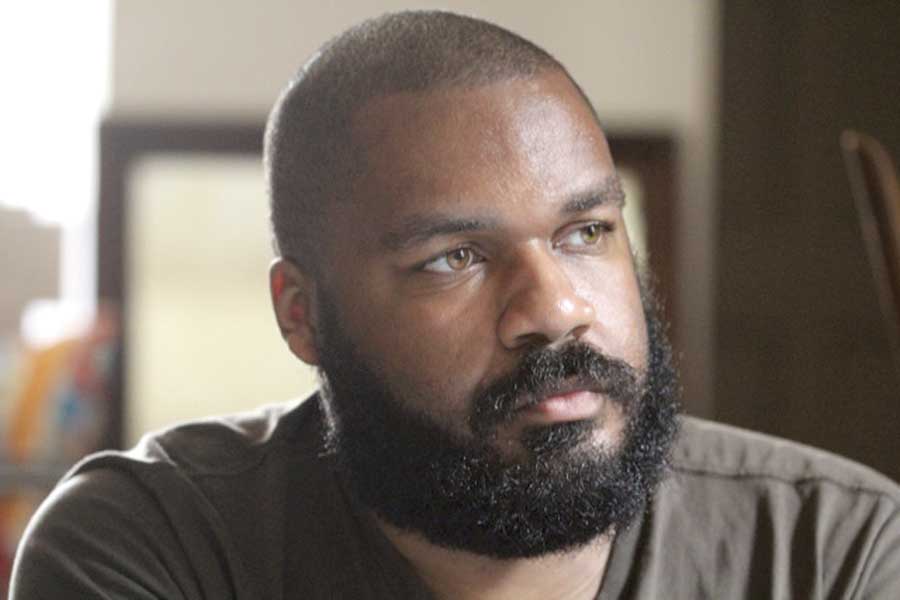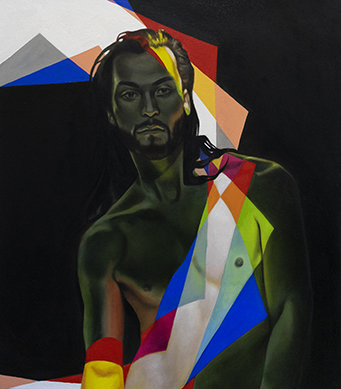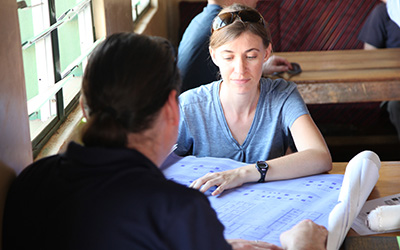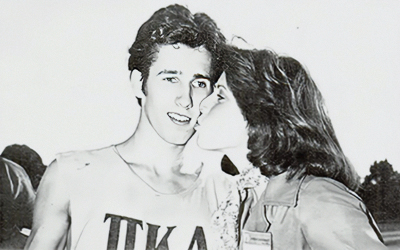To find creative inspiration, an artist turned to the subject he knew best: himself.

Auburn Magazine: There are a lot of elements to your work—classical art, U.S. history, sexuality, pop culture and more. What moves you to artistic inspiration?
I find that I am inspired visually by the world around me all the time, but only occasionally does the feeling compel me to make work. Likewise, I can have a number of concepts or social observations simmering in my thoughts, but only sometimes will I make work or write about it. What typically happens is that a visual will embed itself in my mind (typically coming from some mundane place) and it will stay there until the right concept comes along to make it worthy of existing beyond just a thought. I spend a pretty long time—in some cases months or years—contemplating a visual idea before it ever gets presented in anything remotely tangible.
A lot of your work features or is inspired by the human body. What about anatomy or the use of real people helps you creatively?
Using real people allows me to talk about social or personal issues without having to specifically spell things out. We all develop the ability to read into a person’s physical presentation and make a pretty detailed and wide-ranging network of assumptions. Making figurative work allows me to use those assumptions as raw material within the work. The body is a very efficient conveyor of meaning, especially when you are wanting to work with fairly complicated ideas.
The greatest challenge with models is time! Their time, my time, our time together. Usually, the challenge is there isn’t enough time. It presents a bunch of limitations that I have learned to work with over the years. For example, I generally work from images of live models and not specifically “from life” as one would in a figure drawing class. Work from me can potentially exist in any number of forms, so I conduct photoshoots and then use that content as a resource for whatever I determine later.
A huge opportunity with models is the unexpected happy accidents. I often have a particular image in my head, but a model will always interpret that information differently. You end up discovering new and often stronger visuals by having these ideas filtered through someone else’s body and lived experiences.
Your paintings are stunningly realistic in their anatomy, but often contain dream-like elements—what internal vision (if any) are you trying to bring to life?
I’ve been obsessed with the magic of realism since I started painting and have always wanted to further improve the ability to simulate reality. The dream-like qualities started to creep into the work early on and had a great deal to do with the process of painting itself.
You learn a lot of things about vision, the limitations of human sight and the way we perceive reality in the process of attempting realism. So, from early on I was interested as much in the parts of paintings that can’t be discerned clearly as much as the fully rendered areas of a work.
How did Auburn help you achieve the kind of art you wanted to make?
I didn’t know I wanted to be an artist before coming to Auburn. I knew that I wanted to be in a creative field, and I left high school thinking that I would either be a graphic or industrial designer. Soon after starting in the Industrial Design Program at Auburn, I realized I liked the creative component but not any of the other parts. After a few days in the program, I transferred to the Art Department, and over a couple of semesters I found painting the most rewarding format.
I found that the Auburn arts faculty really matched whatever intent one had for their education. I was enthusiastic about certain things, and as a result, so were they. I got a lot of one-on-one advice on all fronts and it definitely helped me make more of my time there.
How did your MFA at Temple University’s Tyler School of Art help you develop as an artist?
Tyler exposed me to such a big pool of other artists to gain inspiration from. From your fellow classmates who come from very different backgrounds, to the visiting artists and lecturers. I was the only realist out of my entire graduate program, so it really helped me develop a better understanding of the “why” in my work. It was also great just getting so many perspectives on the work you make and deciding for yourself which is worth acting on.
What are the differences studying art in the South versus the North? Changes in inspiration?
When I was an art student in the South, the way I experienced the art world was through books and magazines. Artforum, for example, was this thick tome of a magazine and all the ads would be for shows happening “now,” but nowhere near where I lived.
I think being farther away from major art centers made me work harder hold myself to a high standard, as the way I was seeing the work from elsewhere in the world was through pristine print reproductions.

“Prism,” oil on canvas (2019)
It definitely made for some funny and reassuring realizations once you traveled and saw some of these famous works in person. I remember being so shocked that Picasso paintings often have sloppy paint-splattered edges. Frank Stella paintings are not as crisp and geometrically perfect as they seemed in books. It turned out I was pushing myself to a standard that didn’t quite exist, but it ultimately made me a better artist.
In the North, your proximity to famous works and huge museums is much closer. Studying in Philadelphia meant seeing major works and contemporary shows in New York and DC was just a day trip away. Artforum went from being a reference book for shows I’d never see, to being a guide to use when planning your day in Chelsea. Though the overall pace of living and making work in the Philly was a bit maddening. So, I suppose the biggest difference is that it was easier to see work in the Northeast, but it was easier to focus and make work in the south.
What was your reasoning for publishing your “Southern Exposure” series as Zines?
Accessibility very quickly becomes a concern when making artwork. It can be a challenge getting your work in front of people, and gallery setting can put limits on who feels they are allowed to enjoy the work. Zines allow me to create a personal experience with the viewer that can be enjoyed at their own pace. Zines are much easier to own, and I get to provide a viewer a guided experience anytime they pick one up.
The biggest challenges are mostly logistical: I shoot the content, design the zines, and once they are printed, I would travel to art book and zine fairs around the country to sell them. It can be exhausting, especially when doing it on your own. However, I like having so much control over the presentation and content. Also, getting to travel with them means I have had actual conversations with 80 percent of the people who own one of my zines. It is a level of access and community that is hard to replicate in another format.
Southern Exposure was an opportunity to center work around my thoughts on issues, without making it all about me! Because they are zines, the stakes are lower, and you are only ever communicating with one person holding the work at a time. They was no grand strategy, and the issue format allowed me to just work on what’s next. My goal was to use the flag to promote ideas the founders of the Confederacy would have never agreed with—promoting black and brown bodies, queer bodies, and a dismantling of aging notions of masculinity.
Pt. 4, “Vir Heroicus Sublimis,” features a quote from Barnett Newman, a major figure in abstract expressionism, and references one of his most famous works. What about Newman—and that particular piece—spoke to you?
I was first drawn to the sheer scale of many of his paintings. “Vir Heroicus Sublimis” is over 17 feet wide, and the recommended viewing distance is so close that the painting takes up your full field of view. You are forced to confront this huge field of color in a really primal sensory experience. After a couple of minutes, the stripes of white start to hover and vibrate on the surface
As a realist painter, I’ve been heavily influenced by Caravaggio and other Baroque era painters. In terms of contemporary work, I’m drawn to the work of Richard Philips, Will Cotton, Wangetchi Mutu, Kris Knight, and too many other artists to name. I also love minimalist work, so Ad Reinhardt, Agnes Martin, James Turrell Dan Flavin, and others pretty heavily influence how I think about much of the work I create.
What do you like to do when you’re not creating or seeking inspiration?
I like gardening. I’ve had an herb and vegetable container garden wherever I lived for nearly a decade now, and I like the way it makes me appreciate things I generally find unappealing about the outdoors, like the heat and bugs. Knowing the heat of summer makes my rosemary plants happy sort of helps me appreciate it.
What did you do during the COVID-19 Pandemic? Did it alter anything about your creative process? As for creating work, the pandemic posed huge challenges. All artbook fairs suddenly had to transition to virtual or were cancelled altogether, so that changed how I got printed work out into the world. I also couldn’t work with models without significant changes to the process due to social distancing concerns. I had work in a gallery show this past fall that opened and closed without me—or hardly anyone else—getting to see it in person.
I relocated to Cleveland, Ohio literally a week before the wave of national lockdowns last March, and luckily, it’s a pretty large space that includes my studio. It’s been a pretty strange experience living someplace fairly unfamiliar and not really having much of an ability to explore it. It suddenly meant I had a huge amount of indoor time to work with, so I ended up hopping from interest to interest. I got back into sewing so that I could make masks that would fit my beard! That became a fun pastime and I ended up making dozens of masks that I would send back to my family in Montgomery. From there, I moved to baking, then gardening—basically hitting all the common things people tried while stuck at home. My plants have never been happier! Overall, it’s reminded me to just follow wherever the creative impulse goes, and be OK with that, meaning things slow down a bit on the creation of artwork.
What advice do you have anyone who wants to become a professional artist themselves?
First, give yourself permission to do or make the things you want. It is very easy to be hard on yourself, feeling that your ideas aren’t good enough or that you aren’t skilled enough. A good remedy to this unnecessary pressure is to look at art out in the world, and you will see that there is ample room for all kinds of work. Going to a gallery or museum definitely helps me not to take so seriously the choices I’m making in my own work.
Secondly, getting work out in public is very important. A website, social media, even local shows at coffee shops and hair salons when you are starting out. At least in my experience, opportunities almost entirely came from other opportunities. Lastly, don’t obsess over concepts like “career advancement.” It’s better to have a few long-term goals, a few short-term goals, and to keep making or doing what you enjoy. After a while, you will look back at the list and realized you accomplished far more than you thought.
Building Hope: Disaster Relief Architecture & Design
Combining faith and design, disaster response architect Sarah Elizabeth Dunn ’03 builds shelters for disaster-stricken communities around the world.
Harold Franklin Reflects on Integration 50 Years Later
Fifty years ago, unsure of his safety, a tall, soft-spoken Black man walked alone across the Auburn campus to register for classes.
Auburn Love Stories: How They Met
From blind dates to football games to chance meetings in the classroom, Auburn alums reflect on how they found love and everlasting romance on the Plains.
Building Hope: Disaster Relief Architecture & Design
Combining faith and design, disaster response architect Sarah Elizabeth Dunn ’03 builds shelters for disaster-stricken communities around the world.
Harold Franklin Reflects on Integration 50 Years Later
Fifty years ago, unsure of his safety, a tall, soft-spoken Black man walked alone across the Auburn campus to register for classes.
Auburn Love Stories: How They Met
From blind dates to football games to chance meetings in the classroom, Auburn alums reflect on how they found love and everlasting romance on the Plains.


